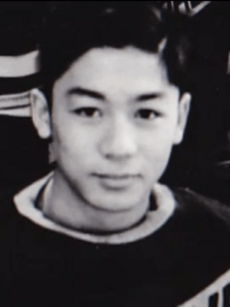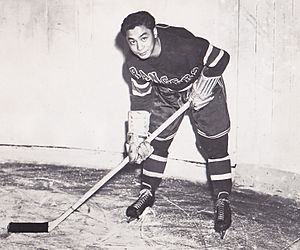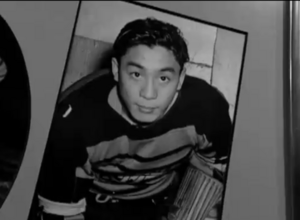Larry Kwong facts for kids
Quick facts for kids Larry Kwong |
|||
|---|---|---|---|

Larry Kwong pictured with the Vernon Hydrophones in the 1938–39 season
|
|||
| Born | June 17, 1923 Vernon, British Columbia, Canada |
||
| Died | March 15, 2018 (aged 94) Calgary, Alberta, Canada |
||
| Height | 5 ft 6 in (168 cm) | ||
| Weight | 150 lb (68 kg; 10 st 10 lb) | ||
| Position | Forward | ||
| Shot | Right | ||
| Played for | New York Rangers | ||
| Playing career | 1941–1959 | ||
Lawrence Kwong (born Eng Kai Geong; Chinese: 吳啟光; June 17, 1923 – March 15, 2018) was a Canadian ice hockey player. He made history as the first non-white and Asian player in the National Hockey League (NHL). He played for the New York Rangers in 1948, breaking the NHL's color barrier. Even though he didn't play much in the NHL, he was a star in other hockey leagues. He even competed against famous players like Jean Béliveau.
Larry came from a family that spoke Cantonese. He was also the first NHL player from Vernon, British Columbia. People called him "China Clipper" and "King Kwong."
After playing hockey, Larry lived in Europe. He became the first coach of Chinese descent for a professional hockey team in Switzerland. Later, he returned to Canada. He ran a supermarket, just like his father did.
Contents
Larry's Early Life
Larry Kwong was born in 1923 in Vernon, British Columbia. He was one of 15 children. His father came from China in 1884. He first looked for gold, then farmed, and finally opened a grocery store. The store was called Kwong Hing Lung. Larry's Chinese last name was Eng. But he chose to use his father's store name, Kwong, as his English last name.
Just two weeks after Larry was born, Canada passed a law. It was called the Chinese Exclusion Act of 1923. This law stopped almost all Chinese immigrants from entering Canada. Larry faced a lot of unfair treatment because of his background. He remembered being turned away from a barbershop.
Starting His Hockey Career
Larry learned to play hockey on frozen ponds in Vernon. He didn't play in an organized league until he was 16. He joined the Vernon Hydrophones. In 1939, he led his team to win the BC midget hockey championship. In 1941, they won the provincial juvenile title.
When he was 18, Larry tried out for the Trail Smoke Eaters. This was a top semi-professional team. They had won the 1939 World Ice Hockey Championships. Players on the team usually got good jobs at a local factory. But Larry was denied a job because he was Chinese. Instead, he had to work as a bellhop at a hotel.
In 1942, the Chicago Black Hawks invited Larry to their training camp. But the Canadian government would not let him leave the country.
In 1944, Larry joined the Canadian Army. He didn't go overseas. Instead, he played hockey for the Red Deer Wheelers. His team played against other army teams.
After World War II, Larry returned to the Trail Smoke Eaters. In 1946, they won the provincial senior hockey championship. Larry was a top scorer in that series. He even scored the winning goal for the Savage Cup.
Later in 1946, Lester Patrick, a famous scout, noticed Larry. He signed Larry to play for the New York Rovers. This team was a farm team for the New York Rangers. Larry scored a goal in his first game for the Rovers. In 1947–1948, Larry was the top scorer for the New York Rovers. He had 86 points in 65 games.
Breaking the NHL Color Barrier

On March 13, 1948, Larry Kwong made history. He became the first non-white player in the NHL. He played for the New York Rangers against the Montreal Canadiens. This happened less than a year after Jackie Robinson broke the color barrier in baseball.
In his NHL game, Larry wore number 11. He was benched for most of the game. He finally got to play in the last minute of the third period. He was on the ice for less than a minute. He didn't score any points. This was his only NHL game.
Even though Larry was the top scorer for the Rovers, he wasn't called up again. He felt he wouldn't get a real chance with the Rangers. So, he left the team. He accepted a better offer to play for the Valleyfield Braves in the Quebec Senior Hockey League.
A Star Outside the NHL
Larry Kwong had a long and successful career. He played in senior leagues in Canada and the United States. He was coached by Toe Blake. In 1951, Larry won the Vimy Trophy. This award is for the Most Valuable Player (MVP) in the QSHL. That year, he led the Valleyfield Braves to win the league championship. They also won the Alexander Cup, which is a big Canadian senior hockey title.
In the next season (1951–52), Larry scored 38 goals. Only Jean Béliveau scored more goals (45). Larry played nine years in the Quebec League. He played against future NHL stars like Béliveau and Jacques Plante. Larry averaged more than a point per game. Béliveau, who later joined the Hockey Hall of Fame, said Larry was a great passer. He made his teammates look good.
Playing and Coaching in Europe
Larry decided to play and coach hockey in Europe. He went to England and then Lausanne, Switzerland. He thought he would only stay a year. But he ended up staying for 15 years! He coached hockey for six years. Then he became a tennis coach.
He played one season with the Nottingham Panthers in Britain. He scored 55 goals in 55 games. Then he moved to Switzerland. He led HC Ambrì-Piotta in scoring as a player-coach. This made him the first person of Chinese descent to coach a professional hockey team. He later coached HC Lugano and HC Lausanne.
Personal Life
Larry Kwong married Audrey Craven in 1964. They had one daughter, Kristina. In 1972, Larry and his family moved back to Canada. He ran the Food-Vale Supermarket with his brother, Jack. This was the same store his father had started. In 1989, Larry married Janine Boyer. She passed away in 1999. Larry retired from the grocery business. He lived in Calgary, Alberta. Larry died on March 15, 2018, in Calgary.
Awards and Achievements
Larry Kwong received many honors for his achievements.
On-Ice Achievements
- 1939: Won the British Columbia Midget Hockey Championship.
- 1941: Won the British Columbia Provincial Juvenile Title.
- 1946: Was the leading scorer on the Trail Smoke Eaters.
- 1946: Won the Savage Cup; scored the cup-winning goal.
- 1948: Was the leading scorer on the New York Rovers (86 points in 65 games).
- 1948: Broke the NHL's color barrier by playing for the New York Rangers. He was the first non-white player in the league.
- 1951: Won the Byng of Vimy Trophy as MVP of the QSHL. He led the league in assists (51).
- 1951: Won the QSHL Championship.
- 1951: Won the Alexander Cup. This is the Canadian national major senior ice hockey championship.
- 1952: Was second in QSHL scoring with 38 goals. Only Jean Beliveau scored more.
- 1958: Scored 55 goals in 55 games for the Nottingham Panthers at age 35.
Special Awards
- 2002: Received Calgary's Asian Heritage Month Award.
- 2009: Received the Heritage Award from the Society of North American Historians and Researchers (SONAHR).
- 2010: Received the first Pioneer Award from the Okanagan Hockey Group.
- November 23, 2011: Inducted into the Okanagan Sports Hall of Fame.
- September 19, 2013: Honored as a member of the B.C. Sports Hall of Fame.
- July 23, 2016: Honored as a member of the Alberta Hockey Hall of Fame.
Larry Kwong's game-worn 1942–43 Nanaimo Clippers jersey is in the Hockey Hall of Fame. It is part of an exhibit called The Changing Face of Hockey – Diversity in Our Game.
Honorary Appearances
- 2009: Honored by the Vernon Vipers of the British Columbia Hockey League before a game.
- 2009: Saluted by the Calgary Flames of the National Hockey League at the Saddledome.
Movies and Media
- 2011: Larry's story is in the documentary film Lost Years: A People's Struggle for Justice.
- 2014: The Shift: The Story of the China Clipper, a documentary, first showed in Vernon, BC.
- 2015: King Kwong: Larry Kwong, the China Clipper who Broke the NHL Colour Barrier, a book about his life, was published.
Career Statistics
| Regular season | Playoffs | |||||||||||||
|---|---|---|---|---|---|---|---|---|---|---|---|---|---|---|
| Season | Team | League | GP | G | A | Pts | PIM | GP | G | A | Pts | PIM | ||
| 1938–41 | Vernon Hydrophones | BCAHA | ||||||||||||
| 1941–42 | Trail Smoke Eaters | ABCHL | 29 | 9 | 13 | 22 | 10 | 3 | 0 | 0 | 0 | 0 | ||
| 1942–43 | Nanaimo Clippers | VISHL | 11 | 6 | 6 | 12 | 0 | 3 | 0 | 1 | 1 | 2 | ||
| 1943–44 | Vancouver St. Regis | NNDHL | 17 | 10 | 6 | 16 | 0 | |||||||
| 1943–44 | Red Deer Wheelers | CAGHL | 2 | 0 | 0 | 0 | 0 | 5 | 1 | 2 | 3 | 0 | ||
| 1944–45 | Did not play | |||||||||||||
| 1945–46 | Trail Smoke Eaters | WKHL | 19 | 12 | 8 | 20 | 12 | 5 | 6 | 0 | 6 | 8 | ||
| 1946–47 | New York Rovers | EAHL | 47 | 19 | 18 | 37 | 15 | 9 | 7 | 3 | 10 | 0 | ||
| 1947–48 | New York Rangers | NHL | 1 | 0 | 0 | 0 | 0 | |||||||
| 1947–48 | New York Rovers | EAHL | 17 | 13 | 16 | 29 | 5 | |||||||
| 1947–48 | New York Rovers | QSHL | 48 | 20 | 37 | 57 | 23 | 4 | 1 | 0 | 1 | 0 | ||
| 1948–49 | Valleyfield Braves | QSHL | 63 | 37 | 47 | 84 | 8 | 3 | 1 | 0 | 1 | 7 | ||
| 1949–50 | Valleyfield Braves | QSHL | 60 | 25 | 35 | 60 | 16 | 5 | 2 | 1 | 3 | 2 | ||
| 1950–51 | Valleyfield Braves | QSHL | 60 | 34 | 51 | 85 | 35 | 16 | 1 | 12 | 13 | 2 | ||
| 1950–51 | Valleyfield Braves | Alx-Cup | 12 | 6 | 9 | 15 | 4 | |||||||
| 1951–52 | Valleyfield Braves | QSHL | 60 | 38 | 28 | 66 | 16 | 6 | 1 | 5 | 6 | 0 | ||
| 1952–53 | Valleyfield Braves | QSHL | 56 | 10 | 22 | 32 | 6 | 3 | 0 | 2 | 2 | 0 | ||
| 1953–54 | Valleyfield Braves | QHL | 68 | 24 | 25 | 49 | 17 | 7 | 3 | 3 | 6 | 2 | ||
| 1954–55 | Valleyfield Braves | QHL | 50 | 24 | 30 | 54 | 8 | |||||||
| 1955–56 | Trois-Rivieres Lions | QHL | 29 | 3 | 6 | 9 | 10 | |||||||
| 1955–56 | Troy Bruins | IHL | 21 | 9 | 9 | 18 | 2 | 5 | 1 | 2 | 3 | 2 | ||
| 1956–57 | Troy Bruins | IHL | 9 | 1 | 0 | 1 | 0 | |||||||
| 1956–57 | Cornwall Chevies | OHA Sr. A | 33 | 14 | 15 | 29 | 22 | 6 | 5 | 1 | 6 | 0 | ||
| 1957–58 | Nottingham Panthers | BNL | 31 | 39 | 15 | 54 | 6 | |||||||
| 1957–58 | Nottingham Panthers | Aut-Cup | 24 | 16 | 9 | 25 | 4 | |||||||
See Also
- List of sports desegregation firsts
- Willie O'Ree, first black player in the NHL, a decade after Larry Kwong broke the color barrier
- Andong Song, the first Chinese-born hockey player to be drafted by an NHL team (New York Islanders)
- Peter Ing, former NHL goalie
- List of players who played only one game in the NHL


